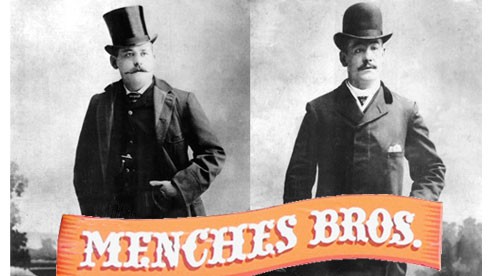July 23, 1904 -
At the turn of the last century, ice-cream men were a breed apart. It was hard work making ice-cream and the rewards were few. "You don't choose ice cream," they said, "ice cream chooses you."
Well, Charles E. Menches was an ice-cream man. They say it ran in his veins. (They say forget the autopsy: they say you don't need actual ice-cream in your blood to have it in your veins.)
Charles E. Menches had always known he'd be an ice-cream man. Everyone had known. While other boys in St. Louis played stickball or jacks, little Chuckie experimented with different creams and salts. While other boys dreamed of being doctors or lawyers, little Chuckie dreamed of exotic flavor combinations like cinnamon-onion swirl and artichoke-pistachio.
Charles E. Menches' passion for ice cream was infectious. He made his brother Frank an ice-cream man. They began traveling to fairs and special events across the Midwest to sell ice cream from a tent. (Apparently, they also had a thing for hamburgers - the brothers also lay claim to having introduced the hamburger to the American public. But that's another story...)
They did what all ice-cream men did: they scooped their ice cream into bowls and sold it to their customers. People loved ice cream back then, just as they love it today. And why not? It was ice cream.
One sweltering day at the St. Louis World's Fair - July 23, 1904, to be precise--Charles E. Menches and his brother Frank sold so much ice cream that they ran out of dishes.
An ordinary ice-cream man might have folded up his tent and taken the rest of the day off. But not Charles E. Menches. Charles E. Menches knew the code of the ice-cream man. More than that, he lived it.
The people of St. Louis would not be denied their ice cream. Not if Charles E. Menches had anything to say about it.
The tent beside Charles and Frank's ice cream tent belonged to Ernest A. Hamwi, a Syrian pastry-maker who sold sweet wafer pastries called Zalabia. (Ernest A. Hamwi was what Syrians would call a Zalabia man, but they wouldn't say he had Zalabia in his veins. Syrians would never talk such tripe.)
In a moment of brilliant epiphany, Charles E. Menches bought all of Ernest A. Hamwi's Zalabia and rolled them into cones. He then began selling his ice cream in sweet wafer cones instead of dishes.
The ice cream cone was born.
(Sure, Italo Marchiony had received U.S. patent #746971 for the ice-cream cone seven months earlier in New York, but Italo Marchiony had never been an ice-cream man.)
And so it goes.





No comments:
Post a Comment